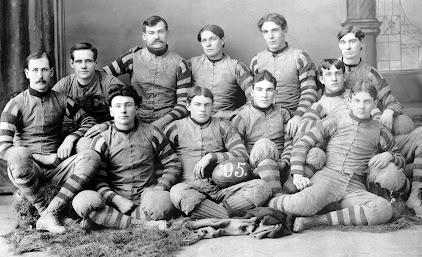Yes, this football score is for real. The year was 1895. Sure, the game then was new and far different from today. But that year the Marietta College Pioneers were dominant. The Parkersburg News in a 1964 article suggested that the 1895 Marietta College team might have been the best ever.
Marietta played OSU eight times in the 1890s - and won two of those games. Not bad since MC Football had just been started in 1893 by Joseph Manley, a Harvard graduate who had played four years of football there. He taught Greek at Marietta. Manley coached and played quarterback; eligibility rules then allowed that.
The October 1995 Marietta College student newspaper The Olio: "The football season of 1895...seems most encouraging. Except for three, the entire team has returned..." It credited "magnificent coaching," hard work, and student body enthusiasm for the team's excellence.
1895 Football team. Photo courtesy of Marietta College Special Collections
Preseason optimism was justified: MC went 4-1-1 that year, outscoring opponents 148 to 12. Wins including beating Ohio State 24-0. The Olio: "The State University went down on November 23, before the superior teamwork and science of the Marietta team. Marietta made gains through the lines, around end and wherever and whenever she wanted to. This was a great victory..."
They lost only to WVU. But the 6-6 tie game at the University of Cincinnati proved the toughest. The game was a big deal. There were 3,500 in the stands for the "Greatest Game the State Ever Knew." It was a bitterly fought, controversial game. Marietta endured unfair officiating and insulting behavior from the UC community.
Referees were openly partisan; two of them wore UC colors. Coach Manley: "No grosser insult was ever offered to gentlemen, under the name of sport." Officiating favored UC. Holding by UC was blatant but not flagged. "Slugging" (hitting with fists or body blows) by UC players was not penalized, causing some MC players serious injury. UC was awarded a touchdown though the ball was a foot short of the goal line. UC was not penalized for fielding "ringers" - ineligible players who played for pay or for other teams. Marietta fans and alums - including the College President John Simpson - were cursed and insulted by unruly UC fans.
There are always two sides to the story. Did MC do or say things that triggered the UC abuse? Don’t know. If reporting is correct, UC was the primary instigator.
Games then often featured similar infractions, though not as extreme as at UC. These issues prompted the college presidents of Ohio to propose new rules in 1896 regarding eligibility, conduct, and safety of players. Team members must be actual students, no compensation of players, referees must be neutral, "slugging" and other foul play would be prohibited.
Other observations about football in that era:
- The word football appeared in print as two words: foot ball.
- Some strategies had been devised for this new sport, as indicated by the term “scientific football” which appears in The Olio several times.
- Only 11 guys are in the team photo. It’s likely that most had to play on offense and defense.
- Many games drew good crowds, though football was new at the time.
- With few dedicated football facilities, game sites had to be carefully planned. Few games were at home fields; some were played at neutral sites.
- Transportation was always an issue - no cars, vans, or buses yet. They mostly went by train or trolley.
- Scoring was different. A touchdown was 4 points, the "point" after was 2 points.
Today MC and OSU are in separate divisions, so we can root for both. Go Pios! Go Bucks!
Thanks to Linda Showalter at Marietta College Special Collections for research assistance on this article.


